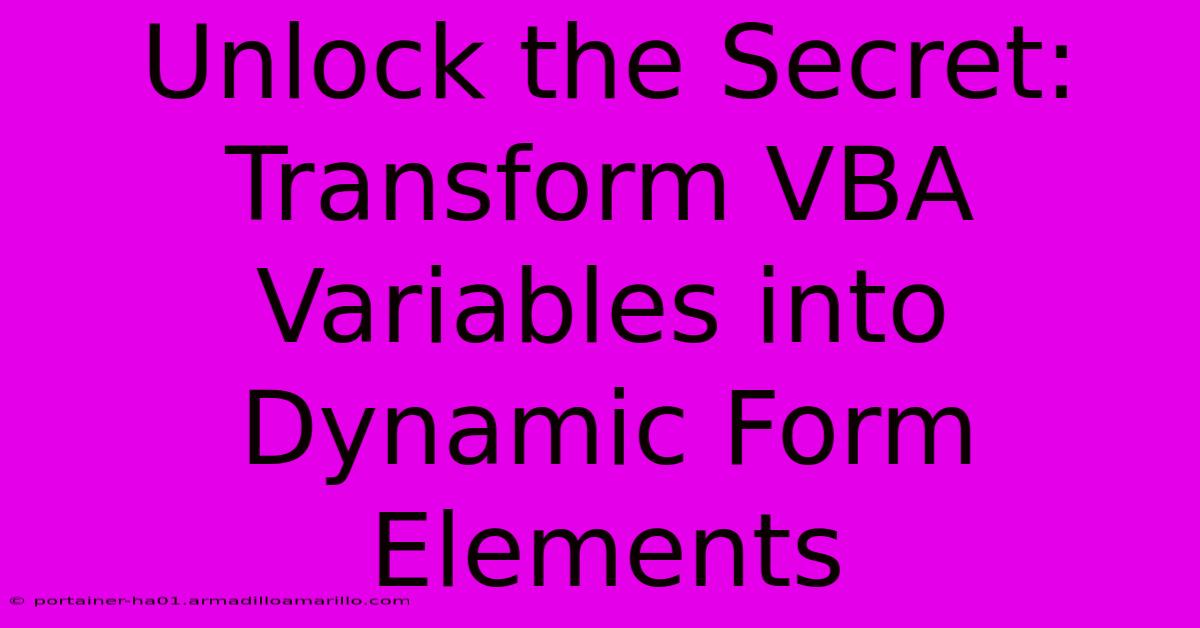Unlock The Secret: Transform VBA Variables Into Dynamic Form Elements

Table of Contents
Unlock the Secret: Transform VBA Variables into Dynamic Form Elements
Are you tired of static forms in your VBA applications? Do you dream of forms that adapt and change based on user input or data retrieved from your system? Then you've come to the right place! This article unlocks the secret to transforming your VBA variables into dynamic form elements, adding a layer of interactivity and sophistication to your projects. We'll explore techniques that empower you to create truly responsive user interfaces.
Understanding the Power of Dynamic Forms
Traditional VBA forms often feel rigid. Once designed, their structure remains fixed. But imagine a form that automatically adds text boxes based on the number of items in a database query, or one that hides fields based on a user's selection. This level of dynamism significantly enhances the user experience, making your applications more intuitive and efficient.
The Benefits of Dynamic Form Generation
- Improved User Experience: Forms adapt to the specific needs of each situation, avoiding clutter and improving clarity.
- Increased Efficiency: Automated form generation reduces manual setup and saves development time.
- Enhanced Flexibility: Easily modify form layouts without extensive code changes.
- Data-Driven Design: Create forms that directly reflect data changes in real-time.
Techniques for Creating Dynamic Forms with VBA Variables
Several approaches enable the transformation of VBA variables into dynamic form elements. Let's examine two effective methods:
1. Leveraging the Controls.Add Method
The Controls.Add method is your primary weapon in dynamically creating form elements. This versatile method allows you to instantiate various controls (text boxes, labels, buttons, etc.) directly within your VBA code.
Example:
Dim i As Integer
Dim txtBox As TextBox
For i = 1 To 5 ' Create 5 text boxes dynamically
Set txtBox = Me.Controls.Add("Forms.TextBox.1", "txtBox" & i)
txtBox.Top = i * 20 ' Adjust vertical position
txtBox.Left = 10 ' Adjust horizontal position
txtBox.Width = 100
Next i
This code snippet iterates five times, adding a new text box with a unique name (txtBox1, txtBox2, etc.) to the active form each time. The Top and Left properties control the placement. You can adapt this to create other controls based on your needs.
Important Considerations:
- Naming Conventions: Use descriptive and consistent naming to manage your dynamically created controls.
- Error Handling: Always include error handling to gracefully manage potential issues during control creation.
- Control Properties: Set relevant properties (size, position, captions, etc.) to ensure optimal layout and functionality.
2. Using Arrays to Manage Dynamic Controls
For more complex scenarios, using arrays to manage dynamically created controls enhances organization and simplifies code maintenance.
Example:
Dim i As Integer
Dim txtBoxes(1 To 5) As TextBox
For i = 1 To 5
Set txtBoxes(i) = Me.Controls.Add("Forms.TextBox.1", "txtBox" & i)
' ... Set other properties ...
Next i
' Accessing a specific textbox:
txtBoxes(3).Value = "Some Text"
This example uses an array to hold references to the dynamically created text boxes. This allows you to access and manipulate them easily later in your code.
Advanced Techniques and Best Practices
- Conditional Form Generation: Create forms that only display relevant fields based on user input or data conditions using
If...Then...Elsestatements. - Data Binding: Link dynamic form elements directly to data sources, so changes in one reflect changes in the other. This creates a truly responsive user interface.
- User Input Validation: Validate user input in dynamically generated fields to ensure data integrity.
- Clear Layout: Consider using tab controls or other layout mechanisms to organize large numbers of dynamically created controls.
Conclusion: Unleash the Full Potential of VBA Forms
Mastering dynamic form generation with VBA opens a world of possibilities. By transforming variables into interactive form elements, you can create sophisticated applications that adapt to user needs and data changes in real-time. Remember to utilize the Controls.Add method, employ arrays for efficient control management, and incorporate best practices for a robust and user-friendly application. Embrace the power of dynamic forms and elevate your VBA projects to the next level!

Thank you for visiting our website wich cover about Unlock The Secret: Transform VBA Variables Into Dynamic Form Elements. We hope the information provided has been useful to you. Feel free to contact us if you have any questions or need further assistance. See you next time and dont miss to bookmark.
Featured Posts
-
Reset Formatting Renaissance Revive Your Docs With A Clean Slate
Feb 06, 2025
-
Unveiled The Mystery Hex Code For Pms 291
Feb 06, 2025
-
Gold Rush Revealed Distinguishing Gold Filled And Gold Plated Jewelry
Feb 06, 2025
-
Diy Pom Pom Extravaganza Transform Your Space With Cheerful Blooms
Feb 06, 2025
-
Beyond Branding Eli Lillys Logo As A Reflection Of Corporate Values
Feb 06, 2025
